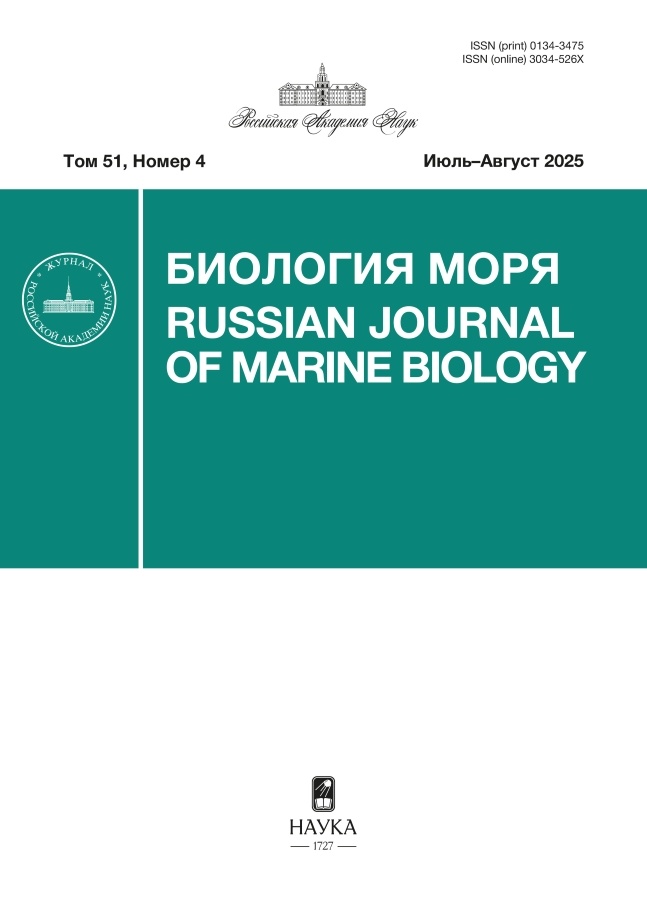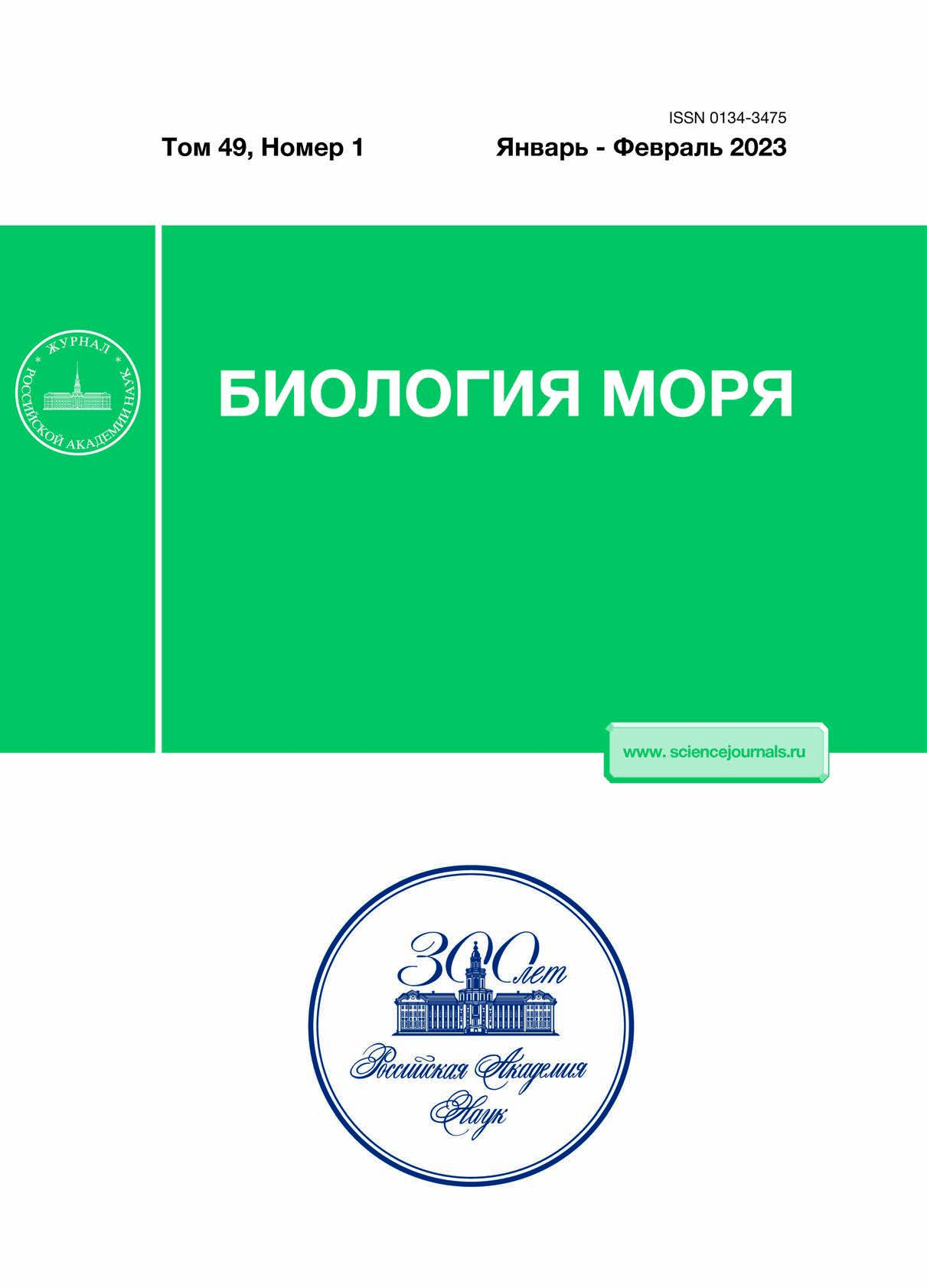Генетическое разнообразие мтДНК дальневосточного трепанга Apostichopus japonicus (Selenka, 1867) (Echinodermata: Holothuroidea) в заливе Петра Великого Японского моря
- Авторы: Ягодина В.Д.1, Брыков В.А.1
-
Учреждения:
- Национальный научный центр морской биологии им. А.В. Жирмунского (ННЦМБ) ДВО РАН
- Выпуск: Том 49, № 1 (2023)
- Страницы: 45-55
- Раздел: ОРИГИНАЛЬНЫЕ СТАТЬИ
- Статья опубликована: 01.01.2023
- URL: https://cardiosomatics.orscience.ru/0134-3475/article/view/670287
- DOI: https://doi.org/10.31857/S0134347523010102
- EDN: https://elibrary.ru/LSPRDP
- ID: 670287
Цитировать
Полный текст
Аннотация
Изучено генетическое разнообразие дальневосточного трепанга Apostichopus japonicus (Selenka, 1867), обитающего в зал. Петра Великого Японского моря. Проанализированы 5 выборок с использованием фрагмента гена COI митохондриальной ДНК. Всего выявлено 16 гаплотипов, при этом гаплотипическое разнообразие было высоким (0.86767 ± 0.01800), а разнообразие нуклеотидов – низким (0.00759 ± 0.00025). Результаты AMOVA и попарного Fst не выявили существенных генетических различий между выборками из зал. Петра Великого. На основе полученных данных и структуры гаплотипической сети, высказано предположение, что дальневосточный трепанг обитает в неравновесных условиях. Это связано с неравномерным расселением молоди, зависящим от гидрологического режима, типа грунта и развития марикультуры в акватории, а также со значительным браконьерским выловом.
Об авторах
В. Д. Ягодина
Национальный научный центр морской биологии им. А.В. Жирмунского (ННЦМБ) ДВО РАН
Автор, ответственный за переписку.
Email: iagodinavd@gmail.com
Россия, 690041, Владивосток
В. А. Брыков
Национальный научный центр морской биологии им. А.В. Жирмунского (ННЦМБ) ДВО РАН
Email: iagodinavd@gmail.com
Россия, 690041, Владивосток
Список литературы
- Левин В.С. Дальневосточный трепанг: биология, промысел, воспроизводство. СПб.: Голанд. 2000. 200 с.
- Лысенко В.Н., Жариков В.В., Лебедев А.М. Современное состояние поселений дальневосточного трепанга Apostichopus japonicus (Selenka, 1867) в Дальневосточном морском заповеднике // Биол. моря. 2018. Т. 44. № 2. С. 134–140.
- Селин Н.И. Вертикальное распределение дальневосточного трепанга Apostichopus japonicus в заливе Восток Японского моря // Биол. моря. 2001. Т. 27. № 4. С. 297–299.
- Терехова В.Е., Белькова Н.Л. Идентификация оппортунистических патогенов трепанга (Apostichopus japonicus), культивируемого в Приморском крае // Вода: химия и экология. 2016. № 1. С. 36–42.
- Adachi K., Okumura S., Moriyama S. Genetic structure of Japanese sea cucumbers (Apostichopus japonicus) along the Sanriku coast supports the effect of earthquakes and related tsunamis // Genetica. 2018. V. 146. № 6. P. 497–503. https://doi.org/10.1007/s10709-018-0041-z
- Avise J.C. Phylogeography: The History and Formation of Species. Harvard: Harvard Univ. Press. 2000. 464 p.
- Bandelt H.-J., Forster P., Röhl A. Median-joining networks for inferring intraspecific phylogenies // Mol. Biol. Evol. 1999. V. 16. № 1. P. 37–48. https://doi.org/10.1093/oxfordjournals.molbev.a026036
- Chang Y., Feng Z., Yu J., Ding J. Genetic variability analysis in five populations of the sea cucumber Stichopus (Apostichopus) japonicus from China, Russia, South Korea and Japan as revealed by microsatellite markers // Mar. Ecol. 2009. V. 30. P. 455–461. https://doi.org/10.1111/j.1439-0485.2009.00292.x
- Chen L., Yang J. Microsatellite genetic variation in wild and hatchery populations of the sea cucumber (Apostichopus japonicus Selenka) from northern China // Aqua. Res. 2008. V. 39. P. 1541–1549. https://doi.org/10.1111/j.1365-2109.2008.02027.x
- Dong Y., Li Q., Zhong X., Kong L. Development of gene-derived SNP markers and their application for the assessment of genetic diversity in wild and cultured populations in sea cucumber, Apostichopus japonicus // J. World Aqua. Soc. 2016. V. 47. № 6. P. 873–888. https://doi.org/10.1007/s12686-013-9858-z
- Du H., Bao Z., Yan J. et al. Development of 101 gene-based single nucleotide polymorphism markers in sea cucumber, Apostichopus japonicus // Int. J. Mol. Sci. 2012. V. 13. P. 7080–7097. https://doi.org/10.3390/ijms13067080
- Edgar R.C. MUSCLE: a multiple sequence alignment method with reduced time and space complexity // BMC Bioinform. 2004. V. 5. P. 113. https://doi.org/10.1186/1471-2105-5-113
- Excoffier L., Lischer H.E.L. Arlequin suite ver 3.5: A new series of programs to perform population genetics analyses under Linux and Windows // Mol. Ecol. Resour. 2010. V. 10. P. 564–567. https://doi.org/10.1111/j.1755-0998.2010.02847.x
- Excoffier L., Smouse P., Quattro J. Analysis of molecular variance inferred from metric distances among DNA haplotypes: Application to human mitochondrial DNA restriction data // Genetics. 1992. V. 131. P. 479–491. https://doi.org/10.1093/genetics/131.2.479
- Felsenstein J. Confidence limits on phylogenies: An approach using the bootstrap // Evolution. 1985. V. 39. P. 783–791. https://doi.org/10.1111/j.1558-5646.1985.tb004
- Fu Y.X. Statistical test of neutrality of mutation against population growth, hitchhiking and background selection // Genetics. 1997. V. 147. № 2. P. 915–925. https://doi.org/10.1093/genetics/147.2.915
- Hamamoto K., Soliman T., Poliseno A., Iria Fernandez-Silva I., Reimer J.D. Higher genetic diversity of the common sea cucumber Holothuria (Halodeima) atra in marine protected areas of the Central and Southern Ryukyu Islands // Front. Conserv. Sci. 2021. V. 2. P. 736633. https://doi.org/10.3389/fcosc.2021.736633
- Harpending R.C. Signature of ancient population growth in a low-resolution mitochondrial DNA mismatch distribution // Hum. Biol. 1994. V. 66. P. 591–600.
- Hedgecock D., Pudovkin A.I. Sweepstakes reproductive success in highly fecund marine fish and shellfish: a review and commentary // Bull. Mar. Sci. 2011. V. 87. № 4. P. 971–1002. https://doi.org/10.5343/bms.2010.1051
- Hoareau T.B., Boissin E. Design of phylum-specific hybrid primers for DNA barcoding: addressing the need for efficient COI amplification in the Echinodermata // Mol. Ecol. Res. 2010. V. 10. P. 960–967. https://doi.org/10.1111/j.1755-0998.2010.02848.x
- Kanno M., Li Q., Kijima A. Microsatellite analysis of Japanese sea cucumber, Stichopus (Apostichopus) japonicus, supports reproductive isolation in color variants // Mar. Biotech. 2006. V. 8. P. 672–685. https://doi.org/10.1007/s10126-006-6014-8
- Karl S.A., Toonen R.J., Grant W.S., Bowen B.W. Common misconceptions in molecular ecology: echoes of the modern synthesis // Mol. Ecol. 2012. V. 21. P. 4171–4189. https://doi.org/10.1111/j.1365-294X.2012.05576.x
- Kim M., Choi T., An H.S. Population genetic structure of sea cucumber, Stichopus japonicus in Korea using microsa-tellite markers // Aqua. Res. 2008. V. 39. P. 1038–1045. https://doi.org/10.1111/j.1365-2109.2008.01962.x
- Kimura M. A simple method for estimating evolutionary rates of base substitutions through comparative studies of nucleotide sequences // J. Mol. Evol. 1980. V. 16. № 2. P. 111–120. https://doi.org/10.1007/BF01731581
- Marjoram P., Donnelly P. Pairwise comparisons of mitochondrial DNA sequences in subdivided populations and implications for early human evolution // Gene-tics. 1994. V. 136. P. 673–683. https://doi.org/10.1093/genetics/136.2.673
- Nehemia A., Kochzius M. Reduced genetic diversity and alteration of gene flow in a fiddler crab due to mangrove degradation // PLoS One. 2017. V. 12. P.8. https://doi.org/10.1371/journal.pone.0182987
- Oh G.-W., Ko S.-C., Lee D.H. et al. Biological activities and biomedical potential of sea cucumber (Stichopus japo-nicus): a review // Fish. Aqua. Sci. 2017. V. 20. https://doi.org/10.1186/s41240-017-0071-y
- Palumbi S.R., Wilson A.C. Mitochondrial DNA diversity in the sea urchins Strongylocentrotus purpuratus and S. droebachiensis // Evolution. 1990. V. 44. P. 403–415. https://doi.org/10.1111/j.1558-5646.1990.tb05208.x
- Purcell S.W., Samyn Y., Conand C. Commercially important sea cucumbers of the world // FAO Species Catalogue for Fishery Purposes № 6 / Eds. N. De Angelis, A. Lovatelli. 2012. P. 223.
- Qiu T., Zhang T., Hamel J.-F., Mercier A. Development, settlement, and post-settlement growth // The Sea Cucumber Apostichopus japonicus History, Biology and Aquaculture / Eds. H. Yang, J.-F. Hamel, A. Mercier. Academic Press. 2015. P. 111–131. https://doi.org/10.1016/B978-0-12-799953-1.00008-8
- Ray N., Currat M., Excoffier L. Intra-deme molecular diversity in spatially expanding populations // Mol. Biol. Evol. 2003. V. 20. P. 76–86. https://doi.org/10.1093/molbev/msg009
- Rodrigues F., Valente S., González-Wanguemert M. Genetic diversity across geographical scales in marine coastal ecosystems: Holothuria arguinensis a model species // J. Exp. Mar. Biol. Ecol. 2015. V. 463. P. 158–167. https://doi.org/10.1016/j.jembe.2014.12.006
- Rogers A.R. Genetic evidence for a Pleistocene population expansion // Evolution. 1995. V. 49. P. 608–615. https://doi.org/10.1111/j.1558-5646.1995.tb02297.x
- Rozas J., Ferrer-Mata A., Sánchez-DelBarrio J.C. et al. DnaSP 6: DNA sequence polymorphism analysis of large datasets // Mol. Biol. Evol. 2017. V. 34. № 12. P. 3299–3302.https://doi.org/10.1093/molbe v/msx248
- Schneider S., Excoffier L. Estimation of past demographic parameters from the distribution of pairwise differences when the mutation rates vary among sites: application to human mitochondrial DNA // Genetics. 1999. V. 152. P. 1079–1089. https://doi.org/10.1093/genetics/152.3.1079
- Selenka E. Beiträge zur Anatomie und Systematik der Holothurien // Zoology. 1867. V. 17. P. 291–374.
- Simões T.D., Azevedo E., Silva F.H. et al. Ecological traits of sea cucumbers with commercial relevance from the north-eastern Atlantic coast // Front. Mar. Sci. Conference Abstract: IMMR'18. 2019. https://doi.org/10.3389/conf.FMARS.2018.06.00147
- So J., Uthicke S., Hamel J.-F., Mercier A. Genetic population structure in a commercial marine invertebrate with long-lived lecithotrophic larvae: Cucumaria frondosa (Echinodermata: Holothuroidea) // Mar. Biol. 2011. V. 158. P. 859–870. https://doi.org/10.1007/s00227-010-1613-3
- Soliman T., Kanno M., Kijima A., Yamazaki Y. Population genetic structure and gene flow in the Japanese sea cucumber Apostichopus japonicus across Toyama Bay, Japan // Fish. Sci. 2012. V. 78. P. 775–783. https://doi.org/10.1007/s12562-012-0509-1
- Soliman T., Fernandez-Silva I., Reimer J.D. Genetic population structure and low genetic diversity in the over-exploited sea cucumber Holothuria edulis Lesson, 1830 (Echinodermata: Holothuroidea) in Okinawa Island // Conserv. Genetics. 2016. V. 17. P. 811–821. https://doi.org/10.1007/s10592-016-0823-8
- Tajima F. Statistical method for testing the neutral mutation hypothesis by DNA polymorphism // Genetics. 1989. V. 123. P. 585–595. https://doi.org/10.1093/genetics/123.3.585
- Tamura K., Stecher G., Kumar S. MEGA11: Molecular Evolutionary Genetics Analysis version 11 // Mol. Biol. Evol. 2021. V. 38. P. 3022–3027. https://doi.org/10.1093/molbev/msab120
- Truett G.E. Preparation of Genomic DNA from Animal Tissues // DNA Sequencing II: Optimizing Preparation and Cleanup / Ed. J. Kieleczawa. Sudbury: Jones and Bartlett Publishers. 2006. P. 33–46.
- Tyler P.A., Young C.M.D., Billett S.M., Giles L.A. Pairing behaviour, reproduction and diet in the deep-sea holothurian genus Paroriza (Holothurioidea: Synallactidae) // J. Mar. Biol. Assoc. U. K. 1992. V. 72.2. P. 447–462. https://doi.org/10.1017/S0025315400037814
- Uthicke S., Benzie J.A.H. Gene flow and population history in high dispersal marine invertebrates: Mitochondrial DNA analysis of Holothuria nobilis (Echinodermata: Holothuroidea) populations from the Indo-pacific // Mol. Ecol. 2003. V. 12. P. 2635–2648. https://doi.org/10.1046/j.1365-294X.2003.01954.x
- Valente S., Serrão E.A., González-Wangüemert M. West versus East Mediterranean Sea: origin and genetic diffe-rentiation of the sea cucumber Holothuria polii // Mar. Ecol. 2014. V. 36. № 3. P. 485–495. https://doi.org/10.1111/maec.12156
- Watts R.J., Johnson M.S., Black R. Effects of recruitment on genetic patchiness in the urchin Echinometra mathaei in Western Australia // Mar. Biol. 1990. V. 105. P. 145–151.
- Yagodina V.D., Bondar E.I., Brykov V.A. Genetic variability and population structure of the Japanese sea cucumber, Apostichopus japonicus Selenka, 1867 revealed by microsatellites in Peter the Great Gulf, Sea of Japan // Mar. Biodivers. 2022. V. 52. P. 40. https://doi.org/10.1007/s12526-022-01278-0
- Yan J., Jing J., Mu X. et al. A genetic linkage map of the sea cucumber (Apostichopus japonicus) based on microsa-tellites and SNPs // Aquaculture. 2013. V. 404–405. P. 1–7. https://doi.org/10.1016/j.aquaculture.2013.04.011
Дополнительные файлы















